***This post is a part of my series where this year I will be highlighting all of the different states native frogs and toads. Check out this page to see all of the United State’s native frogs broken down by state. ***
Here are the frogs and Toads that can be found in Wyoming:
American Bullfrog (Lithobates catesbeianus)

The American Bullfrog is the largest frog in Kansas. They are typically green or gray-brown with brown spots. They can grow up to 6.5″ in length and weigh up to a 1 pound. The bullfrog can be found near large permanent bodies of water with vegetation near the shorelines. In Kansas, they can be found from North Platte River to Douglas and up the Laramine River past Wheatland, there is another population that was introduced at a warm springs near Kelly.

Bullfrogs will eat almost anything that will fit in their mouths. They have been known to eat spiders, fish, birds and even small mammals. It has a very deep call which resembles the mooing of a cow. Watch the video below to hear! Both genders of the bullfrog croak. Their calls may be heard day or night between May and August.
Boreal Chorus Frog (Pseudacris maculata)

The Boreal Chorus frog is brown with 3 dark lateral stripes or spots down its back with a white upper lip and measures up to 1-1/2″ long. These frogs are typically found near heavily vegetated bodies of water, but also need a shallow open area for breeding. These frogs may be found across Wyoming, but are seldom seen due to their size and secrecy.

The boreal chorus frog sounds similar to the spring peeper in that it sounds like fingers running over a comb, however the boreal chorus frog’s call is more tinny and mechanical opposed to the musical whistle of the spring peeper. Females lay 500-1,500 eggs in groups of 5-300. Listen to the call below.
Columbia Spotted Frog (Rana luteiventris)
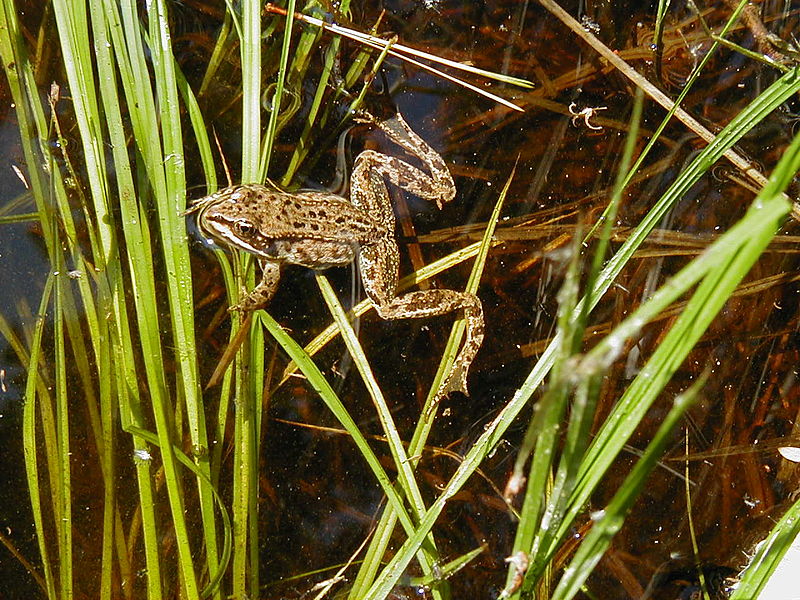
The Columbia Spotted frog has slightly bumpy skin that is smooth and moist. They are typically brown or olive color with irregular spots. They are known for their lower abdomen being bright salmon or a red color. This frog is high aquatic and can rarely be found far from a permanent water source. The range of the Columbia spotted frog within Wyoming is in the northwestern foothills and montane life zones from the Absaroka mountains south into the Wyoming range and wind river range. Another population exists in the Big Horn Mountains.

The call of the columbia spotted frog is a clucking noise and sounds like the clicking of your tongue on the roof of your mouth. Listen to the video below and around 52 seconds you can hear the frog calling.
Great Basin Spadefoot (Spea intermontana)
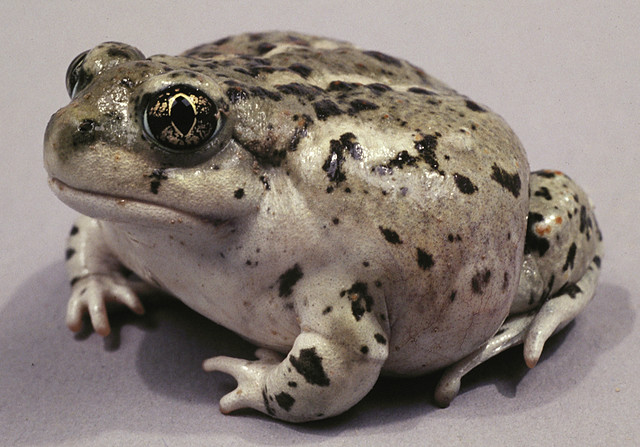
Similar to the Plains spadefoot, the Great Basin spadefoot has a vertical pupil as well. They can be greenish, gray or brown with a scattering of darker spots and blotches. Each spadefoot has a wedge shaped spade on their hind feet, hence the name. They can be found in pools and ponds or flooding in basins in or near the Great Divide Basin within Wyoming.

Their call is a very nasal waaaaa sound. Listen to it below:
Great Plains Toad (Anaxyrus cognatus)

The great plains toad has numerous warts and prominent ridges on its head. The females will typically reach 3″ with males being less. The great plains toad can be found in the northeastern counties of Wyoming. They burrow well in loose soil and are found at night roadside or in ditches where insects are bountiful.

A female great plains toad will lay up to 20,000 eggs. The male great plains toad has a long trill call that lasts 20-50 seconds long and can vary depending on the size of the male and the temperature. Some people have compared this toad’s call to a jackhammer, but go ahead and listen to it for yourself below:
Northern Leopard Frog (Lithobates pipiens)

The Northern Leopard frog has 2-3 unevenly spaced rows of irregular oval shaped dots on its back. The northern leopard frog can be found statewide in mountains and lowlands, but is rarely seen in the extreme northwestern corner of Wyoming. It needs 3 different habitats to match its lifestyle – permanent water for overwintering, floodplains & marshes for breeding & meadows and fields for foraging.

These frogs are opportunistic feeders, meaning that they will eat anything that fits in their mouth including beetles, ants, smaller frogs – including their own species, birds and even garter snakes. It’s call is like a low and rumbling snore and grunt sound. It has also been known to scream loudly when grasped or frightened by a predator. Listen below to their call.
Plains Spadefoot (Spea bombifrons)

The Plains spadefoot is known for its vertically elongated pupil and markings similar to a hourglass on its upper sides. The spadefoot may have some green on its back and sides and some tiny reddish warts. On the underside of each hind foot, there is a wedge shaped spade. They can be found in the eastern portion of Wyoming.

The plains spadefoot spends most of its life buried in the soil, but will emerge to breed after heavy rains in spring or summer. The plains spadefoot is an explosive breeder and many frogs will appear suddenly after a heavy rain. A female can produce up to 2,000 eggs which will hatch in a few days. They produce a compound in their blood which keep their blood from freezing in the winter. The call of the plains spadefoot is a brief snoring sound. Take a listen below.
Western Toad (Bufo boreas)
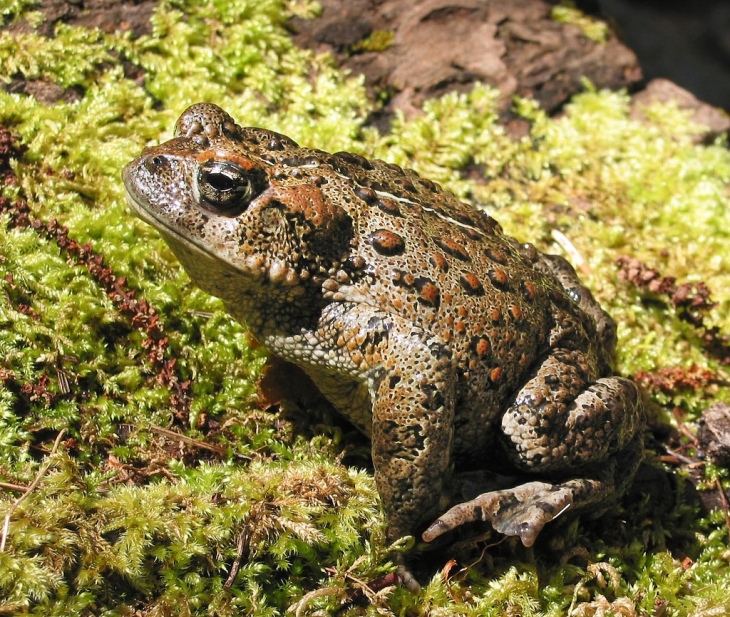
The western (boreal) toad is chunky, with short legs and numerous warts (it is a toad after all). It can vary in color from brown to green or gray with white and dark mottling on its tummy. There is a conspicuous light colored stripe running down the middle of its back. Their back feet have 2 large rubbery knobs on the heel which they use for digging. The western toad can be found in the montane regions and areas between 7,500 and 11,500 feet in the western and south central regions.

Their call is a soft birdlike clucking call. Listen to it in the video below. When handled, the toad may emit a twittery sound, puff up and urinate. These toads are active during daylight hours and are much more active during damp weather.
Wood Frog (Rana sylvatica/ Lithobates sylvaticus)
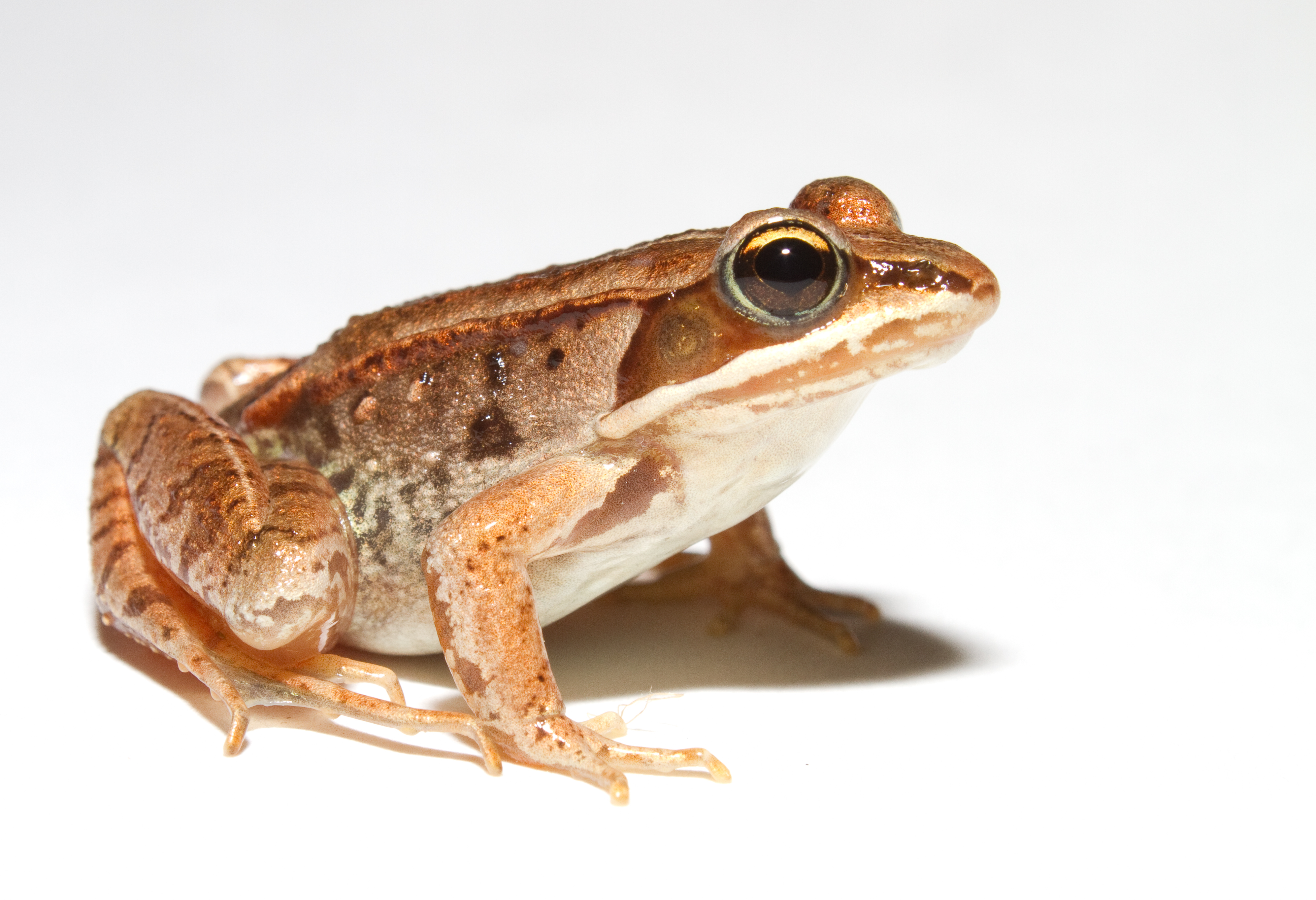
The wood frog has a dark mask on its face and a light stripe down its back. It can be found in marshes, forests, meadows, lakes, ponds and even in potholes. They can be found in the Snowy Range and the Big Horn Mountains within Wyoming.

The wood frog females will lay her eggs in a mass the size of a tennis ball. This mass will include several hundred eggs. This frog has an unusual call which sounds like a chorus of ducks quacking. Listen to its call below!
Woodhouse’s Toad (Anaxyrus woodhousii woodhousii)

Woodhouse’s toad can vary in color from yellowish brown to greenish grey with a light stripe down the middle of its back. They can reach up to 4″ in length! These toads can be found throughout the north and eastern portion of Wyoming. They burrow into soil to escape drought and cold. Woodhouse’s toads are named after a 19th century explorer and naturalist Samuel Woodhouse.

These toads breed from late March to mid-May in marshes, rain pools and other areas lacking strong current. This toad’s call is a loud wahhhhhh lasting between 1-4 seconds and emitted several times a minute. This call is similar to the Fowler’s toad, but with a slightly lower pitch.
Wyoming Toad (Bufo baxteri)
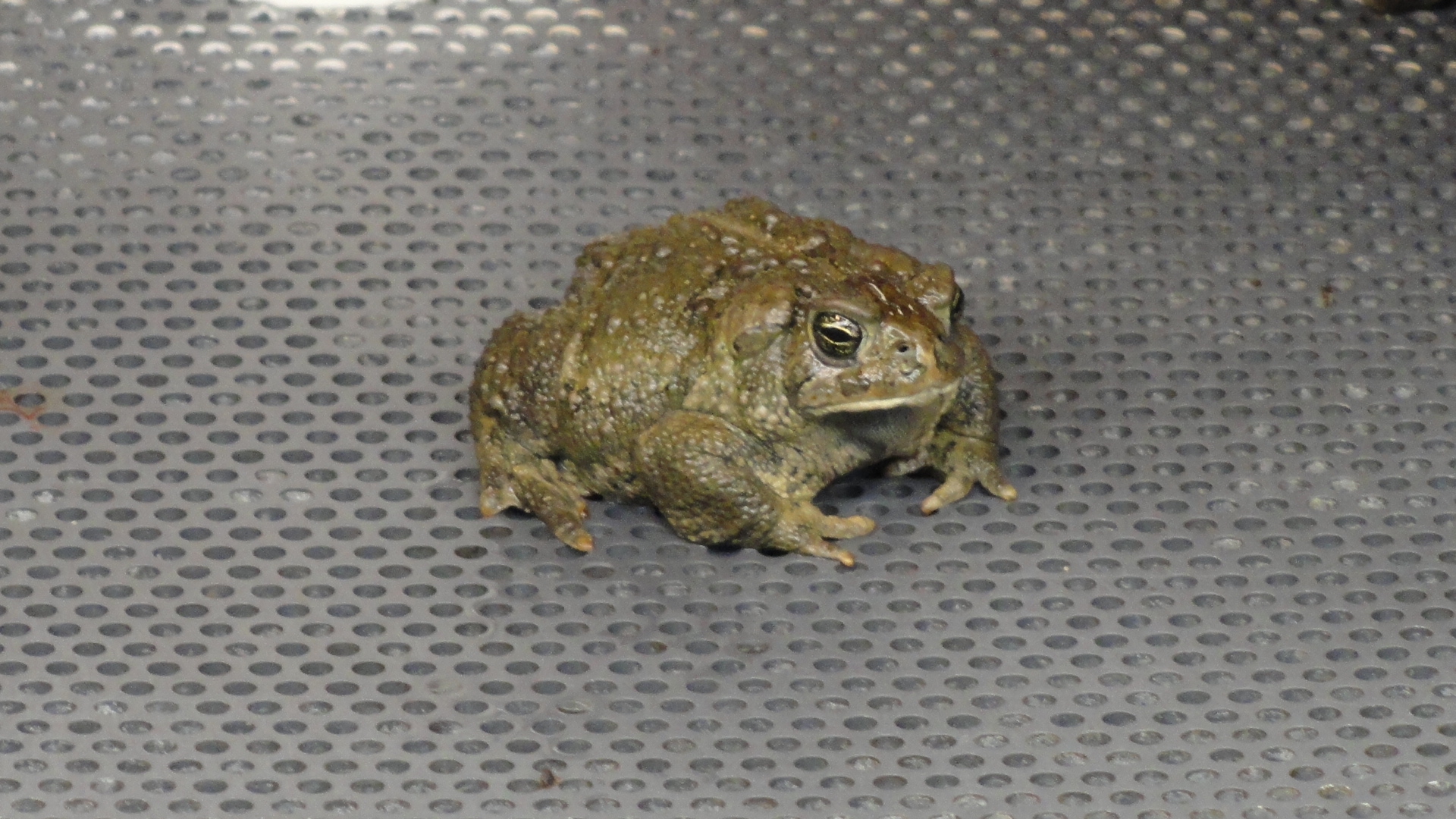
The Wyoming Toad is gray, olive or brown with a white stripe running down its back mottled with cream or white reaching around 2″ in length. They can be found in uninhabited areas near ponds or lakes and the fields along the Laramie River within Wyoming.

The call is hardly recording as there is such a limited range.
Thanks for reading! Check out all of the United State’s native frogs and toads here.

Photo Credits:
Cover photo used by the CC0/public domain license. Text was added. See Original photo here.
- Photo from Wikimedia Commons used under the Creative Commons license. Photo taken by Brian Gratwicke. Original Photo Here.
- Photo from Flickr Wikimedia Commons used under the Creative Commons license. Photo taken by J. N. Stuart. Original Photo Here.
- Photo from Wikimedia Commons used under the Creative Commons license. Photo taken by Forest Service Northern Region. Original Photo Here.
- Photo from Flickr Wikimedia Commons used under the Creative Commons license. Photo taken by Kerry Matz. Original Photo Here.
- Photo from Wikimedia Commons used under the Creative Commons license. Photo taken by Galactor. Original Photo Here.
- Photo from Wikipedia Commons used under the Creative Commons license. Photo taken by Brian Gratwicke. Original Photo Here.
- Photo from Flickr Wikimedia Commons used under the Creative Commons license. Photo taken by Stanley Trauth. Original Photo Here.
- Photo from Flickr and used under the Creative Commons license. Photo by Oregon State University. Original photo here.
- Photo from Wikimedia Commons used under the Creative Commons license. Photo taken by Brian Gratwicke. Original Photo Here.
- Photo from Flickr Wikimedia Commons used under the Creative Commons license. Photo taken by J.N. Stuart. Original Photo Here.
- Photo from Flickr Wikimedia Commons used under the Creative Commons license. Photo taken by Bridget Fahey/USFWS. Original Photo Here.
Like “The Frog Lady” on facebook or follow aapanaro on instagram to get some sneak peeks into the frog lady’s frog room!

